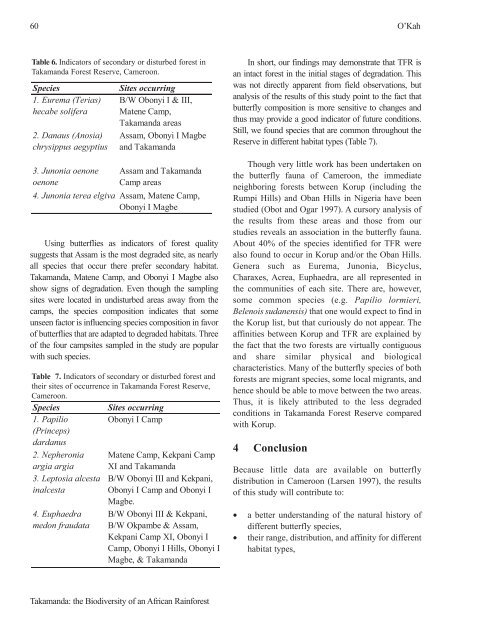Fisheries in the Southern Border Zone of Takamanda - Impact ...
Fisheries in the Southern Border Zone of Takamanda - Impact ...
Fisheries in the Southern Border Zone of Takamanda - Impact ...
You also want an ePaper? Increase the reach of your titles
YUMPU automatically turns print PDFs into web optimized ePapers that Google loves.
60 O’Kah<br />
Table 6. Indicators <strong>of</strong> secondary or disturbed forest <strong>in</strong><br />
<strong>Takamanda</strong> Forest Reserve, Cameroon.<br />
Species Sites occurr<strong>in</strong>g<br />
1. Eurema (Terias)<br />
hecabe solifera<br />
2. Danaus (Anosia)<br />
chrysippus aegyptius<br />
3. Junonia oenone<br />
oenone<br />
B/W Obonyi I & III,<br />
Matene Camp,<br />
<strong>Takamanda</strong> areas<br />
Assam, Obonyi I Magbe<br />
and <strong>Takamanda</strong><br />
Assam and <strong>Takamanda</strong><br />
Camp areas<br />
4. Junonia terea elgiva Assam, Matene Camp,<br />
Obonyi I Magbe<br />
Us<strong>in</strong>g butterflies as <strong>in</strong>dicators <strong>of</strong> forest quality<br />
suggests that Assam is <strong>the</strong> most degraded site, as nearly<br />
all species that occur <strong>the</strong>re prefer secondary habitat.<br />
<strong>Takamanda</strong>, Matene Camp, and Obonyi I Magbe also<br />
show signs <strong>of</strong> degradation. Even though <strong>the</strong> sampl<strong>in</strong>g<br />
sites were located <strong>in</strong> undisturbed areas away from <strong>the</strong><br />
camps, <strong>the</strong> species composition <strong>in</strong>dicates that some<br />
unseen factor is <strong>in</strong>fluenc<strong>in</strong>g species composition <strong>in</strong> favor<br />
<strong>of</strong> butterflies that are adapted to degraded habitats. Three<br />
<strong>of</strong> <strong>the</strong> four campsites sampled <strong>in</strong> <strong>the</strong> study are popular<br />
with such species.<br />
Table 7. Indicators <strong>of</strong> secondary or disturbed forest and<br />
<strong>the</strong>ir sites <strong>of</strong> occurrence <strong>in</strong> <strong>Takamanda</strong> Forest Reserve,<br />
Cameroon.<br />
Species Sites occurr<strong>in</strong>g<br />
1. Papilio Obonyi I Camp<br />
(Pr<strong>in</strong>ceps)<br />
dardanus<br />
2. Nepheronia Matene Camp, Kekpani Camp<br />
argia argia XI and <strong>Takamanda</strong><br />
3. Leptosia alcesta<br />
<strong>in</strong>alcesta<br />
4. Euphaedra<br />
medon fraudata<br />
B/W Obonyi III and Kekpani,<br />
Obonyi I Camp and Obonyi I<br />
Magbe.<br />
B/W Obonyi III & Kekpani,<br />
B/W Okpambe & Assam,<br />
Kekpani Camp XI, Obonyi I<br />
Camp, Obonyi I Hills, Obonyi I<br />
Magbe, & <strong>Takamanda</strong><br />
<strong>Takamanda</strong>: <strong>the</strong> Biodiversity <strong>of</strong> an African Ra<strong>in</strong>forest<br />
In short, our f<strong>in</strong>d<strong>in</strong>gs may demonstrate that TFR is<br />
an <strong>in</strong>tact forest <strong>in</strong> <strong>the</strong> <strong>in</strong>itial stages <strong>of</strong> degradation. This<br />
was not directly apparent from field observations, but<br />
analysis <strong>of</strong> <strong>the</strong> results <strong>of</strong> this study po<strong>in</strong>t to <strong>the</strong> fact that<br />
butterfly composition is more sensitive to changes and<br />
thus may provide a good <strong>in</strong>dicator <strong>of</strong> future conditions.<br />
Still, we found species that are common throughout <strong>the</strong><br />
Reserve <strong>in</strong> different habitat types (Table 7).<br />
Though very little work has been undertaken on<br />
<strong>the</strong> butterfly fauna <strong>of</strong> Cameroon, <strong>the</strong> immediate<br />
neighbor<strong>in</strong>g forests between Korup (<strong>in</strong>clud<strong>in</strong>g <strong>the</strong><br />
Rumpi Hills) and Oban Hills <strong>in</strong> Nigeria have been<br />
studied (Obot and Ogar 1997). A cursory analysis <strong>of</strong><br />
<strong>the</strong> results from <strong>the</strong>se areas and those from our<br />
studies reveals an association <strong>in</strong> <strong>the</strong> butterfly fauna.<br />
About 40% <strong>of</strong> <strong>the</strong> species identified for TFR were<br />
also found to occur <strong>in</strong> Korup and/or <strong>the</strong> Oban Hills.<br />
Genera such as Eurema, Junonia, Bicyclus,<br />
Charaxes, Acrea, Euphaedra, are all represented <strong>in</strong><br />
<strong>the</strong> communities <strong>of</strong> each site. There are, however,<br />
some common species (e.g. Papilio lormieri,<br />
Belenois sudanensis) that one would expect to f<strong>in</strong>d <strong>in</strong><br />
<strong>the</strong> Korup list, but that curiously do not appear. The<br />
aff<strong>in</strong>ities between Korup and TFR are expla<strong>in</strong>ed by<br />
<strong>the</strong> fact that <strong>the</strong> two forests are virtually contiguous<br />
and share similar physical and biological<br />
characteristics. Many <strong>of</strong> <strong>the</strong> butterfly species <strong>of</strong> both<br />
forests are migrant species, some local migrants, and<br />
hence should be able to move between <strong>the</strong> two areas.<br />
Thus, it is likely attributed to <strong>the</strong> less degraded<br />
conditions <strong>in</strong> <strong>Takamanda</strong> Forest Reserve compared<br />
with Korup.<br />
4 Conclusion<br />
Because little data are available on butterfly<br />
distribution <strong>in</strong> Cameroon (Larsen 1997), <strong>the</strong> results<br />
<strong>of</strong> this study will contribute to:<br />
• a better understand<strong>in</strong>g <strong>of</strong> <strong>the</strong> natural history <strong>of</strong><br />
different butterfly species,<br />
• <strong>the</strong>ir range, distribution, and aff<strong>in</strong>ity for different<br />
habitat types,

















